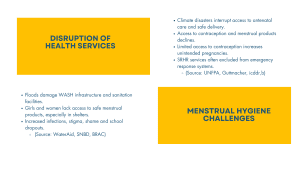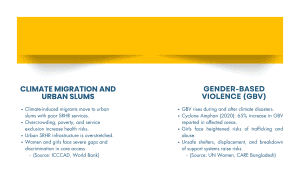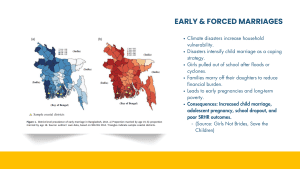SRHR and Climate Change in Bangladesh: Understanding Intersections and Pathways for Action
Bangladesh & Climate Vulnerability
Bangladesh, ranked among the top ten most climate-vulnerable countries globally, faces acute environmental threats due to its deltaic geography, dense population, and widespread poverty. The country is regularly impacted by sea-level rise, tropical cyclones, flooding, salinity intrusion, and increasingly extreme heat—hazards that jeopardise both rural livelihoods and urban infrastructure. By 2013, climate change had already displaced approximately 6.5 million people, leading to growing migration to urban areas and placing significant strain on already overburdened services such as housing, water, and healthcare. (arrow.org.my, populationmedicine.eu).

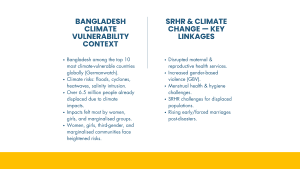
Key Linkages Between SRHR & Climate Change
1. Disrupted Maternal & Reproductive Health Services
- Climate shocks like floods and cyclones disrupt access to maternal care, antenatal services, and family planning, increasing unintended pregnancies and maternal mortality (dhakatribune.com).
- Heat stress raises risks of preterm birth by ~5% per 1 °C increase; Bangladesh’s 16.2% preterm birth rate makes this a critical issue (unicef.org).
2. Increase in Gender-Based Violence (GBV)
- After disasters, overcrowded shelters and stress heighten GBV, IPV, sexual exploitation, trafficking, and child marriage (bigd.bracu.ac.bd).
- One study reported a 65% surge in GBV in Cyclone Amphan–affected areas (bigd.bracu.ac.bd).
- Broad evidence links climate shocks with a rise in IPV globally.
3. Menstrual Health & Hygiene Challenges
- Floods destroy water and sanitation infrastructure, disrupting access to menstrual materials, hygiene, and privacy—raising infection risks and dignity issues (dhakatribune.com).
4. SRHR of Climate Migrants & Displaced Populations
- Displacement—both rural-to-urban and coastal-to-inland—forces families into slums with poor SRHR access, and women often face discrimination in healthcare (share-netbangladesh.org).
5. Early & Forced Marriages
-
Economic strain and school closures after disasters prompt child marriages as a coping strategy (bigd.bracu.ac.bd).



Bangladesh-Specific Evidence
- Khulna Division scoping study highlighted: salinity, rainfall variation, and heat worsened child marriage, unplanned pregnancy, GBV, gestational hypertension, and preeclampsia (share-netbangladesh.org).
- UNICEF and DGHS launched Heat-Related Illness Guidelines (May 2024) to protect pregnant women and children, noting a 5% increase in preterm birth per 1 °C rise, and 16% higher during heatwaves (unicef.org).
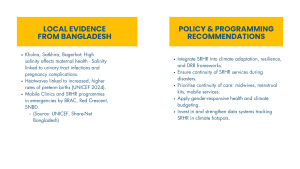
Policy & Programming Recommendations
- Integrate SRHR into Climate Adaptation & DRR Plans
- Share‑Net Bangladesh emphasises bridging SRHR, climate, gender, and SGBV in NAPs (share-netinternational.org).
- Maintain Continuity of Services During Disasters
- Budget mobile clinics, contraceptives, menstrual kits, satellite clinics, rainwater harvesting, and desalination (share-netbangladesh.org).
- Develop GBV/SRHR Response Systems
- Set up safe shelters, increase women’s representation in disaster committees (share-netbangladesh.org).
- Strengthen Data & Monitoring
- Fill gaps in gender-disaggregated SRHR data post-disaster (share-netbangladesh.org).
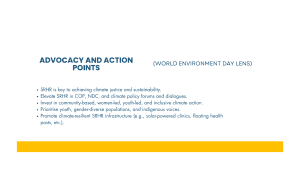
Advocacy Opportunities
- Elevate SRHR in climate and health dialogues — such as COP28, where Bangladesh stakeholders advocated for women’s and adolescent health (serac-bd.org).
- Recognise SRHR under climate justice and human rights frameworks, especially at COP and national policy levels.
- Empower women-led community resilience and climate-smart clinics (e.g., solar power, flood-resistant design).
- Support youth and marginalised groups, including indigenous and gender-diverse communities, in adaptation planning.
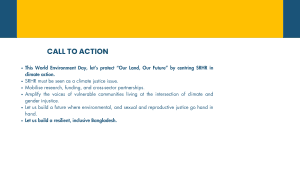
At a Glance
| Challenge | Impact on SRHR |
| Disasters | Disrupt health services, increase maternal risks |
| Overcrowded shelters | Heightened GBV, lack of menstrual dignity |
| Climate migration | Poor SRHR access in slums |
| Salinity & heat | Gestational issues, preterm births |
| Economic stress | Child marriage & early pregnancy |


